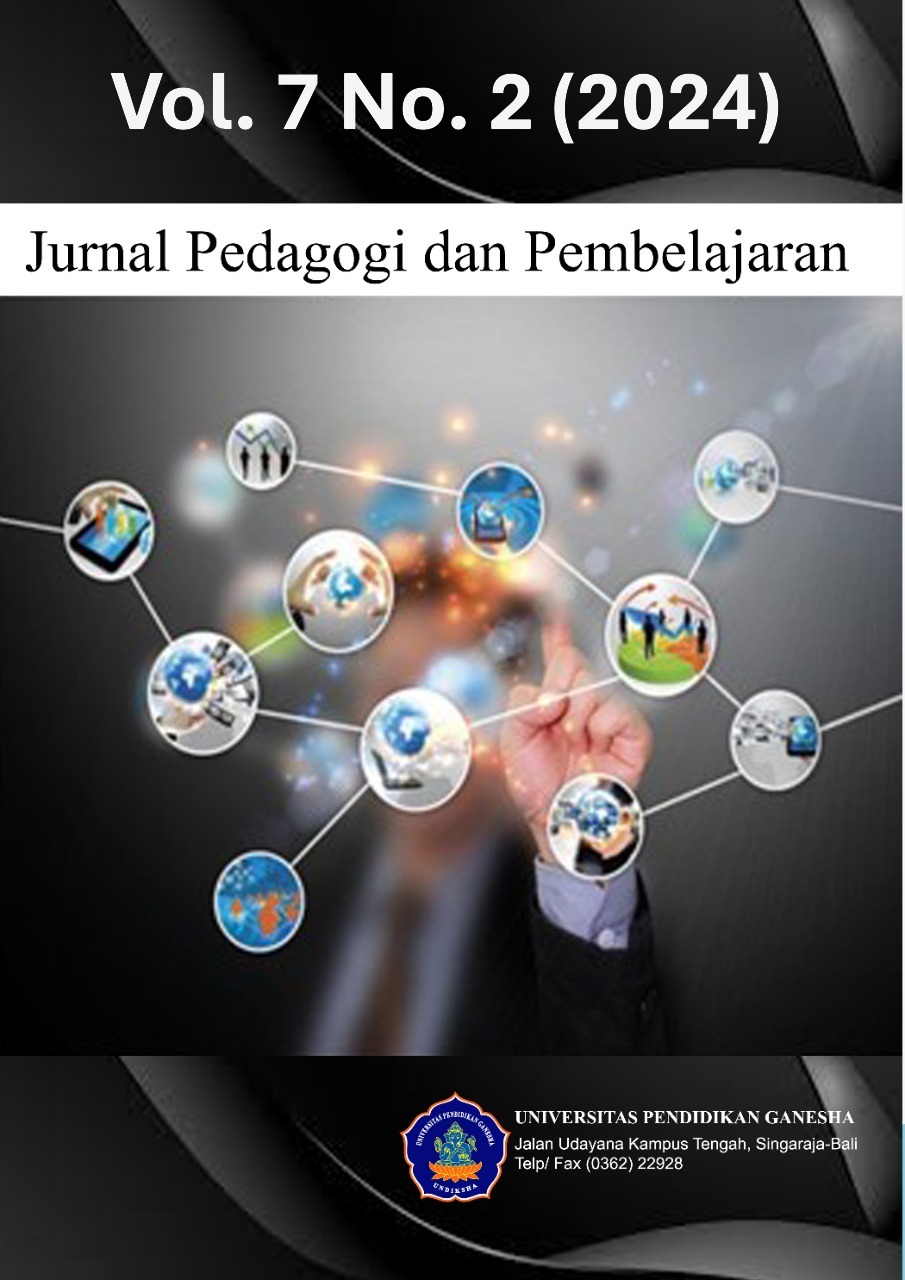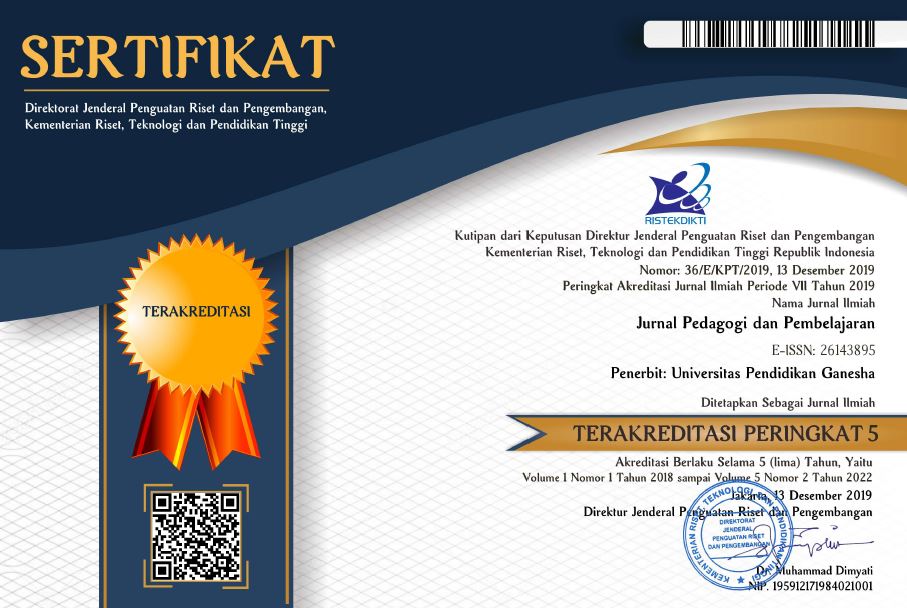Student Scientific Literacy Skills of Competence Aspect in Human Reproductive System Material
DOI:
https://doi.org/10.23887/jp2.v7i2.68594Keywords:
Scientific Literacy Skills, 21st Century Skills, Reproductive SystemAbstract
Technological developments facilitate teachers to develop strategies, methods, teaching materials to enhance students' 21st-century skills. However, not all schools have excellent facilities and teachers who can utilize these facilities to develop learning strategies that support these skills. This situation contrasts with the condition, most of which have good school facilities and teachers who can keep up with technological developments. Therefore, the purpose of this research is to analyze the attainment of scientific literacy skills in human reproductive system material among senior high school students and to investigate the differences in scientific literacy skills in human reproductive system material among schools as a result of school facility and teacher factors. The population for this research comprises class XI senior high school, with a sample of 189 students selected from six schools. This research is descriptive research using a survey method to describe the achievement of students' scientific literacy skills. The instruments used were questionnaires and multiple-choice tests. The collected data were analyzed using descriptive statistics and the Kruskal-Wallis test. The result indicates that the scientific literacy skills of senior high school student in Yogyakarta are good category and there are significant differences in the scientific literacy skills of each school as a result of the availability of school facilities. The conclusion of this research is that there are significant differences in the achievement of students' scientific literacy skills as a result of school facility factors.
References
Abdullah, R. (2017). Pembelajaran Dalam Perspektif Kreativitas Guru Dalam Pemanfaatan Media Pembelajaran. Lantanida Journal, 4(1), 35. https://doi.org/10.22373/lj.v4i1.1866. DOI: https://doi.org/10.22373/lj.v4i1.1866
Adam, T., Bugis, H., & Rohman, N. (2022). Implementasi Pengetahuan, Persepsi, Dan Penerapan Kesehatan Dan Keselamatan Kerja (K3) Pada Pembelajaran Praktik Program Keahlian Teknik Pemesinan Dan Teknik Ototronik Di SMK Negeri 2 Karanganyar. NOZEL Jurnal Pendidikan Teknik Mesin, 4(1), 12. https://doi.org/10.20961/nozel.v1i1.63595. DOI: https://doi.org/10.20961/nozel.v1i1.63595
Ariana, D., Situmorang, R. P., & Krave, A. S. (2020). Pengembangan Modul Berbasis Discovery Learning Pada Materi Jaringan Tumbuhan Untuk Meningkatkan Kemampuan Literasi Sains Siswa Kelas XI IPA SMA. Jurnal Pendidikan Matematika Dan IPA, 11(1), 34. https://doi.org/10.26418/jpmipa.v11i1.31381. DOI: https://doi.org/10.26418/jpmipa.v11i1.31381
Asrial, Syahrial, Maison, Kurniawan, D. A., & Piyana, S. O. (2020). Ethnoconstructivism E-Module to Improve Perception, Interest, and Motivation of Students in Class V Elementary School. JPI (Jurnal Pendidikan Indonesia), 9(1), 30–41. https://doi.org/10.23887/jpi-undiksha.v9i1.19222. DOI: https://doi.org/10.23887/jpi-undiksha.v9i1.19222
Bagasta, A. R., Rahmawati, D., M, D. M. F. Y., Wahyuni, I. P., & Prayitno, B. A. (2018). Profil Kemampuan Literasi Sains Peserta Didik di Salah Satu SMA Negeri Kota Sragen. Pedagogia : Jurnal Pendidikan, 7(2), 121–129. https://doi.org/10.21070/pedagogia.v7i2.1551. DOI: https://doi.org/10.21070/pedagogia.v7i2.1551
Bima, M., Saputro, H., & Efendy, A. (2021). Virtual Laboratory to Support a Practical Learning of Micro Power Generation in Indonesian Vocational High Schools. Open Engineering, 11(1), 508–518. https://doi.org/10.1515/eng-2021-0048. DOI: https://doi.org/10.1515/eng-2021-0048
Bosica, J., Pyper, J. S., & MacGregor, S. (2021). Incorporating problem-based learning in a secondary school mathematics preservice teacher education course. Teaching and Teacher Education, 102, 103335. https://doi.org/10.1016/j.tate.2021.103335. DOI: https://doi.org/10.1016/j.tate.2021.103335
Csanadi, A., Kollar, I., & Fischer, F. (2021). Pre-service teachers’ evidence-based reasoning during pedagogical problem-solving: better together? European Journal of Psychology of Education, 36(1), 147–168. https://doi.org/10.1007/s10212-020-00467-4. DOI: https://doi.org/10.1007/s10212-020-00467-4
Damayanti, A., Juanda, A., & Umami, M. (2021). Pengaruh Pendekatan Scientific Berbantuan Strategi Writing to Learn ( WtL ) terhadap Kemampuan Literasi Sains dan Hasil Belajar Siswa pada Materi Sistem Reproduksi. Prosiding Seminar Nasional Biologi, Saintek, Dan Pembelajarannya, 155–172.
Fatimah, A. S., & Santiana, S. (2017). Teaching in 21St Century: Students-Teachers’ Perceptions of Technology Use in the Classroom. Script Journal: Journal of Linguistic and English Teaching, 2(2), 125. https://doi.org/10.24903/sj.v2i2.132. DOI: https://doi.org/10.24903/sj.v2i2.132
Fuadi, H., Robbia, A. Z., & Jufri, A. W. (2020). Analisis Faktor Penyebab Rendahnya Kemampuan Literasi Sains Peserta Didik. Jurnal Ilmiah Profesi Pendidikan, 5(2), 108–116. https://doi.org/10.29303/jipp.v5i2.122. DOI: https://doi.org/10.29303/jipp.v5i2.122
Gebre, E. (2018). Learning with multiple representations: Infographics as cognitive tools for authentic learning in science literacy. Canadian Journal of Learning and Technology, 44(1), 1–24. https://doi.org/10.21432/cjlt27572. DOI: https://doi.org/10.21432/cjlt27572
Handayani, D., Laksono, D. E., & Novitiana, L. (2017). Pengaruh Perilaku Agresif Terhadap Potensi Kecelakaan Pengendara Sepeda Motor Remaja Dengan Studi Kasus Pelajar Sma Kota Surakarta. Jurnal Riset Rekayasa Sipil, 1(1), 64. https://doi.org/10.20961/jrrs.v1i1.14724. DOI: https://doi.org/10.20961/jrrs.v1i1.14724
Hendri, S., & Hasriani, M. (2019). Identifikasi Literasi Sains Mahasiswa (Studi Kasus Mahasiswa STISIP Amal Ilmiah Yapis Wamena). Journal of Natural Science and Integration, 2(1), 95–104. https://doi.org/10.24014/jnsi.v2i1.7117. DOI: https://doi.org/10.24014/jnsi.v2i1.7117
Irhandayaningsih, A. (2020). Pengukuran Literasi Digital Pada Peserta Pembelajaran Daring Di Masa Pandemi Covid-19. Anuva, 4(2), 231–240. https://demo.dspacedirect.org/bitstream/handle/10673/1975/8073-25123-1-SM.pdf?sequence=1&isAllowed=y. DOI: https://doi.org/10.14710/anuva.4.2.231-240
Jang, M., Aavakare, M., Nikou, S., & Kim, S. (2021). The Impact of Literacy on Intention to Use Digital Technology for Learning: A Comparative Study of Korea and Finland. Telecommunications Policy, 45(7). https://doi.org/10.1016/j.telpol.2021.102154. DOI: https://doi.org/10.1016/j.telpol.2021.102154
Khairunnisa, Yogica, R., Selaras, G. H., & Syamsurizal. (2019). Pengaruh Model Pembelajaran KooperatifTipe Course Review Horay Bermuatan Literasi Sains terhadap Kompetensi Belajar Peserta Didik Pada Materi Sistem Reproduksi Manusia di SMAN 4 Pariaman. Atrium Pendidikan Biologi, 4(3), 35–43. http://dx.doi.org/10.24036/apb.v4i3.6461. DOI: https://doi.org/10.24036/apb.v4i3.6461
Khalid, M. S. (2011). ICT in Education: Secondary Technical Vocational Education and Training Institute Centered Diffusion of Innovation in Rural Bangladesh. In International Technology, Education and Development Conference (pp. 1126–1134). International Association of Technology, Education and Development (IATED). https://vbn.aau.dk/en/publications/ict-in-education-secondary-technical-vocational-education-and-tra.
Lampropoulos, G., Siakas, K., & Anastasiadis, T. (2019). Internet of Things in the Context of Industry 4.0: An Overview. International Journal of Entrepreneurial Knowledge, 7(1), 4–19. https://doi.org/10.2478/ijek-2019-0001. DOI: https://doi.org/10.2478/ijek-2019-0001
Made, I., Dharma, A., Ayu, N., & Lestari, P. (2022). The Impact of Problem-based Learning Models on Social Studies Learning Outcomes and Critical Thinking Skills for Fifth Grade Elementary School Students. Jurnal Ilmiah Sekolah Dasar, 6(2), 263–269. https://doi.org/10.23887/JISD.V6I2.46140. DOI: https://doi.org/10.23887/jisd.v6i2.46140
Mantika, S.P & Purwanto, A. (2022). Pengaruh Fasilitas Belajar, Kompetensi, Dan Kinerja Guru Terhadap Mutu Pendidikan Di Smk Kabupaten Bogor. ACADEMIA: Jurnal Inovasi Riset Akademik, 2(3), 204–213. https://doi.org/10.51878/academia.v2i3.1508. DOI: https://doi.org/10.51878/academia.v2i3.1508
Mayasari, T. (2022). Analisis Kemampuan Literasi Sains Siswa Kelas Xi SMA Negeri di Kota Yogyakarta Mata Pelajaran Biologi Ditinjau dari Kefavoritan Sekolah. Jurnal Edukasi Biologi, 8(1), 86–97. https://doi.org/10.21831/edubio.v8i2.18212. DOI: https://doi.org/10.21831/edubio.v8i2.18212
Muhammad, U., & Widyanto, A. (2019). Internalisasi Nilai-Nilai Toleransi dalam Pembelajaran Pendidikan Agama Islam di SMA Negeri 1 Lhokseumawe. DAYAH: Journal of Islamic Education, 2(1), 36–52. http://dx.doi.org/10.22373/jie.v2i1.2939. DOI: https://doi.org/10.22373/jie.v2i1.2939
Mulyani, R., Fadlika, R. H., & Dewi, T. N. S. (2020). Profil Kemampuan Literasi Sains Berdasarkan Gender di Kelas X. Quagga (Jurnal Pendidikan Dan Biologi), 12(2), 104–109. https://doi.org/10.25134/quagga.v12i2.2326. DOI: https://doi.org/10.25134/quagga.v12i2.2326
Ogan-Bekiroğlu, F., & Arslan, A. (2014). Examination of the Effects of Model-based Inquiry on Students’ Outcomes: Scientific Process Skills and Conceptual Knowledge. Procedia - Social and Behavioral Sciences, 141, 1187–1191. https://doi.org/10.1016/j.sbspro.2014.05.202. DOI: https://doi.org/10.1016/j.sbspro.2014.05.202
Oliver, M. C., & Adkins, M. J. (2020). “Hot-headed” students? Scientific literacy, perceptions and awareness of climate change in 15-year olds across 54 countries. Energy Research and Social Science, 70, 1–9. https://doi.org/10.1016/j.erss.2020.101641. DOI: https://doi.org/10.1016/j.erss.2020.101641
Permatasari, D., & Suprayitno, E. (2021). Pendidikan Kesehatan Reproduksi pada Remaja. Jurnalempathy, 2(1), 8–12. https://doi.org/10.37341/jurnalempathy.v2i1.46. DOI: https://doi.org/10.37341/jurnalempathy.v2i1.46
Priyastuti, M. T., & S. (2020). Kepuasaan Mahasiswa Terhadap Pembelajaran Daring Selama Pandemi Covid-19. Journal of Language and Health, 1(2), 49–56. https://doi.org/10.37287/jlh.v1i2.383. DOI: https://doi.org/10.37287/jlh.v1i2.383
Putri, T. R., Masriani, Rasmawan, R., Hairida, & Erlina. (2022). Analisis Kemampuan Literasi Sains Mahasiswa Pendidikan Kimia di Universitas Tanjungpura. Jurnal IPA & Pembelajaran IPA, 6(2), 164–179. https://doi.org/10.24815/jipi.v6i2.25460. DOI: https://doi.org/10.24815/jipi.v6i2.25460
Rahmadani, F., Setiadi, D., Yamin, M., & Kusmiyati, K. (2022). Analisis Kemampuan Literasi Sains Biologi Peserta Didik SMA Kelas X di SMAN 1 Kuripan. Jurnal Ilmiah Profesi Pendidikan, 7(4b), 2726–2731. https://doi.org/10.29303/jipp.v7i4b.1059. DOI: https://doi.org/10.29303/jipp.v7i4b.1059
Rini, C. P., Dwi Hartantri, S., & Amaliyah, A. (2021). Analisis Kemampuan Literasi Sains Pada Aspek Kompetensi Mahasiswa PGSD FKIP Universitas Muhammadiyah Tangerang. Jurnal Pendidikan Dasar Nusantara, 6(2), 166–179. https://doi.org/10.29407/jpdn.v6i2.15320. DOI: https://doi.org/10.29407/jpdn.v6i2.15320
Rohman, S., Rusilowati, A., & Sulhadi. (2017). Analisis Pembelajaran Fisika Kelas X SMA Negeri di Kota Cirebon Berdasarkan Literasi Sains. Journal Physics Communication, 1(2), 12–18. https://doi.org/10.15294/physcomm.v1i2.10402.
Rukajat, A. (2018). Pendekatan Penelitian Kuantitatif: Quantitative Research Approach. Deepublish.
Sekarwati, A. (2020). Implementasi Pembelajaran Discovery Learning yang Terintegrasi Pendidikan Karakter dalam Pelajaran Biologi. Jurnal Pendidikan Edutama, 7(1). https://doi.org/10.30734/jpe.v7i1.819. DOI: https://doi.org/10.30734/jpe.v7i1.819
Shanks, J. D., Izumi, B., Sun, C., Martin, A., & Shanks, C. B. (2017). Teaching undergraduate students to visualize and communicate Public Health data with infographics. Frontiers in Public Health, 5(NOV), 1–6. https://doi.org/10.3389/fpubh.2017.00315. DOI: https://doi.org/10.3389/fpubh.2017.00315
Stacey, K., & Turner, R. (2015). Assessing mathematical literacy: The PISA experience. Assessing Mathematical Literacy: The PISA Experience, 1–321. https://doi.org/10.1007/978-3-319-10121-7. DOI: https://doi.org/10.1007/978-3-319-10121-7
Suhadi, A. P., Ristanto, R. A., Sigit, D. V, & Supriyatin. (2023). Assessment of Biological Literacy for High School Student. Biosfer: Jurnal Pendidikan Biologi, 16(1), 25–36. https://doi.org/10.21009/biosferjpb.24765. DOI: https://doi.org/10.21009/biosferjpb.24765
Sukowati, D., Rusilowati, A., & Sugianto. (2017). Analisis Kemampuan Literasi Sains Dan Metakogntif Peserta Didik. Physics Communication, 1(1), 16–22. https://doi.org/10.15294/physcomm.v1i1.8961.
Sutrisna, N. (2021). Analisis Kemampuan Literasi Sains Peserta Didik SMA di Kota Sungai Penuh. Jurnal Inovasi Penelitian, 1(12), 2683–2694. https://doi.org/10.47492/jip.v1i12.530.
Temuningsih, Peniati, E., & Marianti, A. (2017). Pengaruh Penerapan Model Problem Based Learning Berpendekatan Etnosains Pada Materi Sistem Reproduksi Terhadap Kemampuan Berpikir Kritis Siswa. Journal of Biology Education, 6(1), 70–79. https://doi.org/10.15294/jbe.v6i1.14060.
Tulaiya, & Wasis. (2020). Analisis Kemampuan Literasi Sains Sains Peserta Didik SMA/MA di Kabupaten Sumenep. IPF: Inovasi Pendidikan Fisika, 9(3), 417–427. https://doi.org/10.26740/ipf.v9n3.p417-427. DOI: https://doi.org/10.26740/ipf.v9n3.p417-427
Turiman, P., Omar, J., Daud, A. M., & Osman, K. (2012). Fostering the 21st Century Skills through Scientific Literacy and Science Process Skills. Procedia - Social and Behavioral Sciences, 59, 110–116. https://doi.org/10.1016/j.sbspro.2012.09.253. DOI: https://doi.org/10.1016/j.sbspro.2012.09.253
Tyan, P. H., Rahman, F. A., & Sarvestani, M. S. (2020). Teachers’ readiness in implementing and facilitating 21st century learning. Universal Journal of Educational Research, 8(1 A), 24–29. https://doi.org/10.13189/ujer.2020.081304. DOI: https://doi.org/10.13189/ujer.2020.081304
Weiss, K. A., McDermott, M. A., & Hand, B. (2022). Characterising immersive argument-based inquiry learning environments in school-based education: A systematic literature review. Studies in Science Education, 58(1), 15–47. https://doi.org/10.1080/03057267 .2021.1897931. DOI: https://doi.org/10.1080/03057267.2021.1897931
Wibowo, T., & Ariyatun, A. (2020). Kemampuan Literasi Sains Pada Siswa Sma Menggunakan Pembelajaran Kimia Berbasis Etnosains. Edusains, 12(2), 214–222. https://doi.org/10.15408/es.v12i2.16382. DOI: https://doi.org/10.15408/es.v12i2.16382
Widiana, R., Maharani, A. D., & Rowdoh. (2020). Pengaruh Model Problem Based Learning terhadap Kemampuan Literasi Sains Siswa SMA. Jurnal Ta’dib, 23(1), 87–94. https://doi.org/10.31958/jt.v23i1.1689. DOI: https://doi.org/10.31958/jt.v23i1.1689
Widowati, A., Widyastuti, L., & Widodo, E. (2019). The profile of students’ scientific literacy in competence aspect in junior high school of Yogyakarta city. Journal of Physics: Conference Series, 1321(3). https://doi.org/10.1088/1742-6596/1321/3/032070. DOI: https://doi.org/10.1088/1742-6596/1321/3/032070
Wiranto, R., & Slameto, S. (2021). Alumni satisfaction in terms of classroom infrastructure, lecturer professionalism, and curriculum. Heliyon, 7(6), e06679. https://doi.org/10.1016/j.heliyon.2021.e06679. DOI: https://doi.org/10.1016/j.heliyon.2021.e06679
Yildirim, S. (2017). Approaches of Designers in the Developed Educational Purposes of Infographics ’ Design Processes. European Journal of Education Studies, 3(1), 248–284. https://doi.org/10.5281/zenodo.231283.
Zubaidah, S. (2016). Keterampilan abad ke-21: Keterampilan yang diajarkan melalui pembelajaran. Seminar Nasional Pendidikan, 1–17. https://www.researchgate.net/profile/siti-zubaidah-7/publication/318013627.
Downloads
Published
How to Cite
Issue
Section
License
Copyright (c) 2024 Alfiya Damayanti -

This work is licensed under a Creative Commons Attribution-ShareAlike 4.0 International License.
Authors who publish with Jurnal Pedagogi dan Pembelajaran agree to the following terms:
- Authors retain copyright and grant the journal the right of first publication with the work simultaneously licensed under a Attribution-ShareAlike 4.0 International (CC BY-SA 4.0) that allows others to share the work with an acknowledgment of the work's authorship and initial publication in this journal
- Authors are able to enter into separate, additional contractual arrangements for the non-exclusive distribution of the journal's published version of the work (e.g., post it to an institutional repository or publish it in a book), with an acknowledgment of its initial publication in this journal.
- Authors are permitted and encouraged to post their work online (e.g., in institutional repositories or on their website) prior to and during the submission process, as it can lead to productive exchanges, as well as earlier and greater citation of published work. (See The Effect of Open Access)











